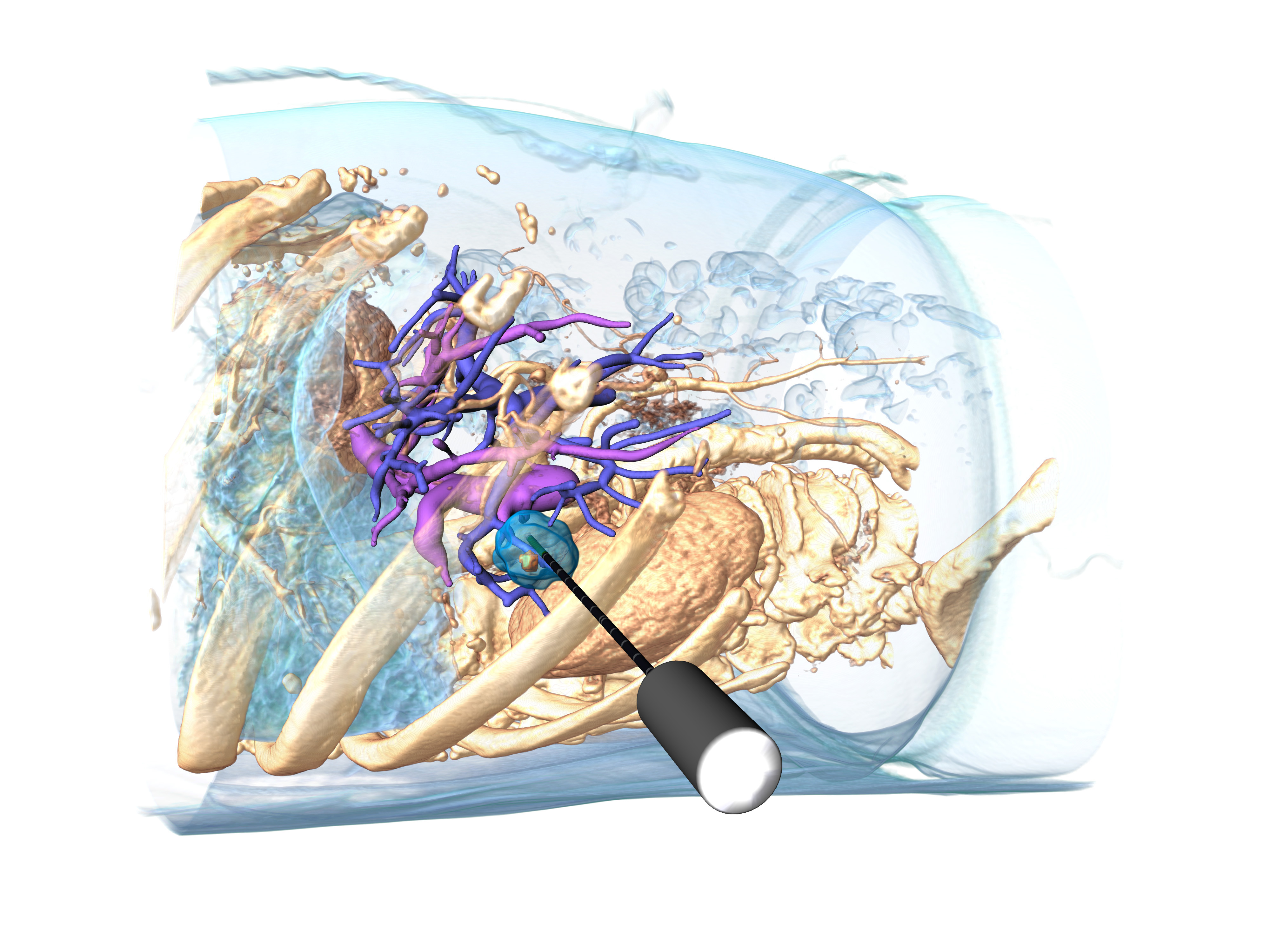Press Release

Image-guided thermal ablation therapy is a patient-friendly, minimally invasive, and cost-effective tumor treatment method. This involves advancing a special needle directly into a tumor using CT and ultrasound to apply heat and destroy it. Until now, interventional radiologists could only estimate the extent to which the applied procedure destroys tumor cells. Hence, thermal ablation is associated with higher local tumor recurrence rates compared with treatment alternatives, causing a real barrier to wide adoption.
The research partnership now underway between Israeli medical technology company TechsoMed Ltd. and the Fraunhofer Institute for Digital Medicine MEVIS in Bremen aims to remedy this shortcoming. The aim is a user-friendly complete system for more targeted and thus more effective thermal ablation. Fraunhofer MEVIS is exclusively licensing its SAFIR technology (Software Assistant for Interventional Radiology), based on years of development, to TechsoMed Ltd. in Israel for thermal ablation under ultrasound control. TechsoMed GmbH, the new subsidiary in Bremen, acts as a research and development center. “We are commencing an intensive and long-term partnership,” says MEVIS Institute Director Horst Hahn. “We share the vision of establishing minimally invasive tumor ablation as a primary therapy option.”
TechsoMed Ltd. has already developed the “BioTrace” imaging software. It is built on algorithms and AI and can visualize tissue viability based on real-time ultrasound images. In cooperation with Fraunhofer MEVIS, the technology will now be developed at the new German R&D Center into a complete system called “BioTrace IO 360”. “The original BioTrace technology will be linked to precise intervention planning and an evaluation of therapeutic success, increasing treatment accuracy and maximizing tumor destruction,” explains Tobias Preusser, managing director of TechsoMed GmbH, deputy institute director of Fraunhofer MEVIS and professor of mathematical modeling of medical processes at Jacobs University in Bremen. “This could make thermal ablation a mainstay of cancer medicine and an alternative to expensive and risky surgery.”
Thermal ablation, used to treat different types of cancer, is very mild and has few side effects. The actual treatment (usually performed under local anesthesia) takes only a few minutes. To position the needle precisely, the procedure is monitored by ultrasound. Once the needle is correctly positioned, the team activates the tip’s energy source, which can be a laser, radiofrequency, or microwave transmitter. It heats the surrounding tissue until it dies from heat exposure. “The key challenge in thermal ablation is to heat the tumor tissue hot enough and long enough that all cancer cells are actually destroyed,” Preusser explains. “Simultaneously, it is important to spare the healthy tissue.”
Because some of the tumor cells only die over the course of 24 hours, the exact extent of the damage can so far not reliably be determined during the procedure. Experts can only rely on their experience to estimate the outcome. This is one factor preventing a broader use of thermal ablation. The BioTrace technology from TechsoMed Ltd. promises a significantly more precise determination of the treatment success. Based on the ultrasound images taken during the procedure, an algorithm detects the damage to the tumor cells and computes its development over the next 24 hours. The result is clearly displayed on a monitor, providing interventional radiologists with critical information on how long and how strongly they need to heat the tumor to achieve optimal treatment success.
With the licensing of SAFIR, the technology has now been definitively expanded. “It is an end-to-end product that combines all treatment steps in a single device for the first time. This makes the staff’s work much easier,” Tobias Preusser emphasizes. Thermal ablation offers an opportunity to treat affected tissue with high localization. “SAFIR helps create a digital model for each patient based on image recordings,” describes Preusser. “AI algorithms automatically recognize the organs and the tumor.” The digital model enables the interventional team to plan the procedure using software that simulates which part of the tissue will be destroyed during ablation. The procedure is performed with the BioTrace algorithm from TechsoMed Ltd., designed for accurate, real-time prediction to assess whether all tumor cells are truly destroyed. The last step is the evaluation of the therapy: a SAFIR algorithm uses image data to determine how high the risk of recurrence is. “This end-to-end solution makes thermal ablation more effective and safer, increasing the likelihood that the tumor will be destroyed. This could be a game-changer for physicians,” says Horst Hahn. In the future, this means that a substantial number of patients who have had to endure surgery and chemotherapy could be treated more gently by image-guided thermal ablation.
“We are pleased that the TechsoMed Team continues to collaborate with us through the new R&D center,” emphasizes Hahn. “The partners complement each other ideally through their years of experience in their respective fields,“ comments Yossi Abu, CEO of TechsoMed Ltd. “The jointly launched subsidiary with SAFIR at its center serves as an incubator for new solutions, initially for tumor therapy and later for other fields of application.” For interventional oncology, we expect wide use of our system for a variety of soft tissue tumors such as liver, kidney, thyroid, prostate, and even breast cancer. “Additional applications of ablation therapy are found in cardiology to treat heart arrhythmia and pain management,” he continues. “The system should also be attractive to emerging and developing countries, where cancer surgery or chemotherapy is often unavailable and too costly for their healthcare systems.”
Material
Related Topics
 Fraunhofer Institute for Digital Medicine MEVIS
Fraunhofer Institute for Digital Medicine MEVIS